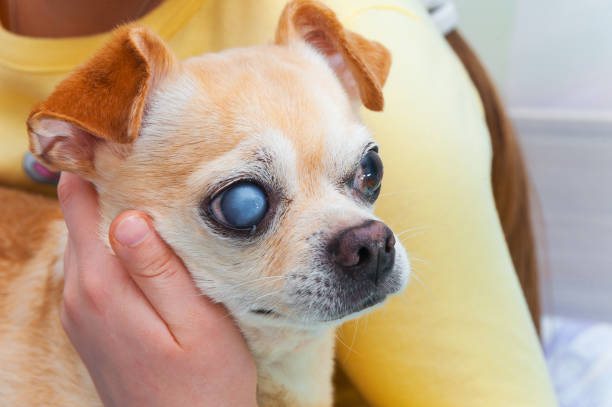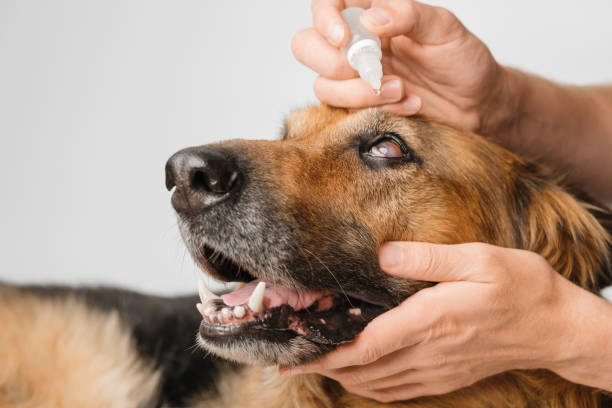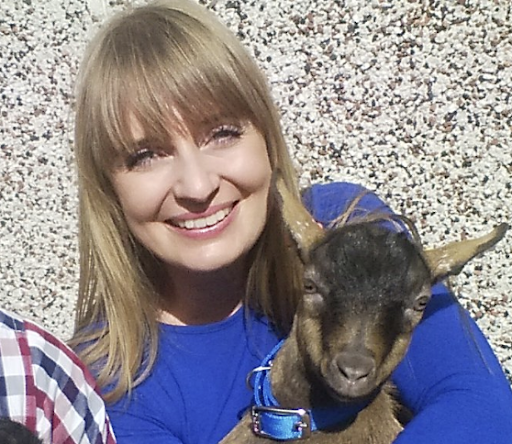Glaucoma in dogs: What you need to know
How to manage glaucoma in dogs, according to a vet.

Glaucoma in dogs is a painful condition caused by high pressure within the eye. Two types of glaucoma can affect our canine companions: primary and secondary.
Glaucoma can lead to blindness if it is left untreated. There is no cure for glaucoma, but luckily there are management options using eye drops and other medications. It is a sad fact that most dogs with glaucoma will eventually go blind, however early detection of the disease and prompt treatment can help to maintain your dog’s vision for longer.
Owners must be able to identify the clinical signs to get their dogs the help they need as soon as possible. I'm a practicing vet with over 13 years of experience in small animal surgery and medicine. I've been a dog owner my entire life and in this feature, I'll give you the low down on glaucoma in dogs.
What is glaucoma in dogs?
Glaucoma is a serious eye condition that affects dogs. It occurs when there is an imbalance in the production and drainage of fluid in the eye, called aqueous humor. This buildup of fluid increases the pressure inside the eye, which can damage the optic disk and the retina.
Glaucoma can be classified in a few different ways. Glaucoma can be open angle or closed angle. Open-angle glaucoma develops gradually over time. It causes loss of vision. Closed-angle glaucoma is an acute condition that occurs very suddenly. It is extremely painful and distressing for dogs.
Glaucoma can be further classified as primary or secondary. Primary glaucoma is usually hereditary - this means it is passed down from dog to dog when they breed. Primary glaucoma is caused by an increase in the intraocular pressure in an otherwise healthy eye. It occurs due to an abnormality in the drainage system of the eye. It usually starts in one eye initially and eventually develops in the other.
Secondary glaucoma is caused by an underlying illness, injury, or health condition that prevents the fluid from draining out of the eye therefore causing an increase in pressure. Secondary glaucoma can affect any age or breed of dog.
Get the best advice, tips and top tech for your beloved Pets
Glaucoma can affect a dog’s sight in several ways. It can cause blurred vision, sensitivity to light, and eventually blindness if left untreated.
Glaucoma can significantly impact a dog's quality of life. Loss of vision can make it harder for dogs to navigate and interact with their environment. The pain associated with glaucoma can also cause distress and discomfort.

What are the symptoms of glaucoma in dogs?
Symptoms of glaucoma vary depending on the underlying cause. One or both eyes can be affected at any time. Glaucoma can develop very suddenly, or it can be a gradual process with only subtle symptoms at first. Typically symptoms include:
- Pain in the eyes
- Eye discharge in dogs/weeping from eyes
- Holding eyes shut/squinting
- Clouding over eyes
- Swollen eyes
- Aversion to bright lights
- Scratching at eyes
- Redness/bloodshot eyes
- Changes in pupil size
- Loss of appetite
- Lethargy in dogs
- Blindness

It is very important to arrange a trip to the vet to have your dog checked out as soon as possible if any of these symptoms are spotted at home.
What are the causes of glaucoma in dogs?
In a normal, healthy eye, there is fluid present called aqueous humor. This is a clear watery liquid that nourishes the lens and the cornea. It also helps to maintain the shape of the eye. This fluid continually flows in and out of the eye. In a dog with glaucoma, there is an obstruction and the fluid is prevented from draining out as normal.
Glaucoma is a complex condition. Here are some of the more common factors that contribute to its development:
- Genetics: Some breeds of dogs are genetically predisposed to developing glaucoma. It is often a hereditary condition.
- Age: Older dogs are more likely to develop glaucoma. As our dogs get older they experience aging changes which can affect their eyes.
- Uveitis: Inflammation within the eye (uveitis) can cause blockage of the drainage pathways in the eye, contributing to glaucoma.
- Infections: Some infections can also lead to increased pressure in the eye and affect drainage.
- Injuries: Any sort of trauma to the eye can increase the risk of glaucoma developing.
- Cancer: Some tumors affect the eye or the tissues surrounding it that can block the drainage pathways which allows the intraocular pressure to build up.
- Underlying disease: Other health issues such as kidney disease or diabetes can contribute to the development of glaucoma.
- Idiopathic: In some cases, the exact cause of glaucoma is not identified. This is called idiopathic glaucoma.
Is there treatment for glaucoma in dogs?
The good news is that there are lots of treatment options for your dog. These will depend on how severe the glaucoma is and what the underlying cause is. Your vet will diagnose glaucoma by measuring the intra-ocular pressure and examining the eye using specialized instruments. Once they have made the diagnosis, your vet will try to decrease the intraocular pressure inside your dog’s eyes as fast as possible. This will reduce the risk of long-term damage to the structures in the eye that could result in blindness. Your vet will then treat any underlying health issues that may have caused glaucoma.
Severe cases of glaucoma are classed as a medical emergency. Emergency treatment will often involve strong pain relief to help your dog feel more comfortable. Your dog will also be prescribed anti-glaucoma medication that aims to promote drainage and reduce fluid production. Depending on how severe the situation is, they may need to stay in hospital for a good few days. They may also require an emergency referral to an eye specialist if things are really bad.
Once your vet has stabilized your furry friend, they will likely need long-term medication to keep their eye pressure at an acceptable level. This usually involves eye drops that owners can apply at home. Drugs may include beta-adrenergic blocking agents, prostaglandins, and carbonic anhydrase inhibitors. In some cases, oral nonsteroidal anti-inflammatory drugs (NSAIDs) or corticosteroids can be prescribed as well to manage inflammation.
In some cases, surgery is indicated. There are various techniques that skilled surgeons can use to decrease intraocular pressure. In certain circumstances, if there is irreversible damage to the eye, or if the dog is in unmanageable pain, an enucleation procedure is performed where the eye is removed.
Unfortunately, glaucoma can cost a lot of money to treat and manage. The medications prescribed are expensive and usually require long-term use. Some options are cheaper than others so it is important to discuss everything with your vet to decide which treatments are most suitable for your furry friend and your financial situation.

Can a dog live with glaucoma?
Glaucoma is a challenging condition for both owners and their dogs. It is a painful and debilitating disease, however, dogs can have a good quality of life and be comfortable if the condition is identified early and managed appropriately.
The pain associated with glaucoma must be addressed. It can be extremely uncomfortable, especially before any treatment has been started. This is because the pressure in the eye can be very high at this point. This causes huge distress.
Once your vet has got the situation under control, there are lots of things owners can do at home to make things easier for their furry friends.
Top tips include:
- Establish a routine. Make sure everyone in the household knows when and how to administer medication so no doses are missed.
- Exercise your dog at quieter times to avoid any potentially stressful situations
- As much as possible, create a calm environment for your dog. Avoid sudden loud noises and keep lighting in rooms consistent.
- Ensure your dog has a quiet relaxing space they can retreat to at all times.
- Keep the layout of the home the same, don't move furniture about as your dog may have trouble bumping into things.
With good vet care, and some forward planning, dogs with glaucoma can live a long and happy life.
You might want to read about eye discharge in dogs.
Emma Chandley is a vet with 14 years of experience and has a keen interest in surgery. After graduating from the Royal Vet College in London in 2011, she achieved a postgraduate certificate in small animal surgery from the British Small Animal Veterinary Association and Nottingham Trent University. She was then awarded advanced practitioner status in the same discipline by The Royal College of Veterinary Surgeons. She has a black Labrador and two pygmy goats at home.

